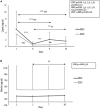Changes in Body Composition, Energy Metabolites and Electrolytes During Winter Survival Training in Male Soldiers
- PMID: 35250611
- PMCID: PMC8889070
- DOI: 10.3389/fphys.2022.797268
Changes in Body Composition, Energy Metabolites and Electrolytes During Winter Survival Training in Male Soldiers
Abstract
The aim of this study was to examine changes in body composition, energy metabolites and electrolytes during a 10-day winter survival training period. Two groups of male soldiers were examined: the REC group (n = 26; age 19.7 ± 1.2 years; BMI 23.9 ± 2.7) had recovery period between days 6 and 8 in the survival training, whereas the EXC group (n = 42; age 19.6 ± 0.8 years; BMI 23.1 ± 2.8) did not. The following data were collected: body composition (bioimpedance), energy balance (food diaries, heart rate variability measurements), and biomarkers (blood samples). In survival training, estimated energy balance was highly negative: -4,323 ± 1,515 kcal/d (EXC) and -4,635 ± 1,742 kcal/d (REC). Between days 1 and 10, body mass decreased by 3.9% (EXC) and 3.0% (REC). On day 6, free fatty acid and urea levels increased, whereas leptin, glucose and potassium decreased in all. Recovery period temporarily reversed some of the changes (body mass, leptin, free fatty acids, and urea) toward baseline levels. Survival training caused a severe energy deficit and reductions in body mass. The early stage of military survival training seems to alter energy, hormonal and fluid metabolism, but these effects disappear after an active recovery period.
Keywords: biomarkers; energy deficit; fat mass; military training; recovery.
Copyright © 2022 Nykänen, Ojanen, Heikkinen, Fogelholm and Kyröläinen.
Conflict of interest statement
The authors declare that the research was conducted in the absence of any commercial or financial relationships that could be construed as a potential conflict of interest.
Figures




References
LinkOut - more resources
Full Text Sources

